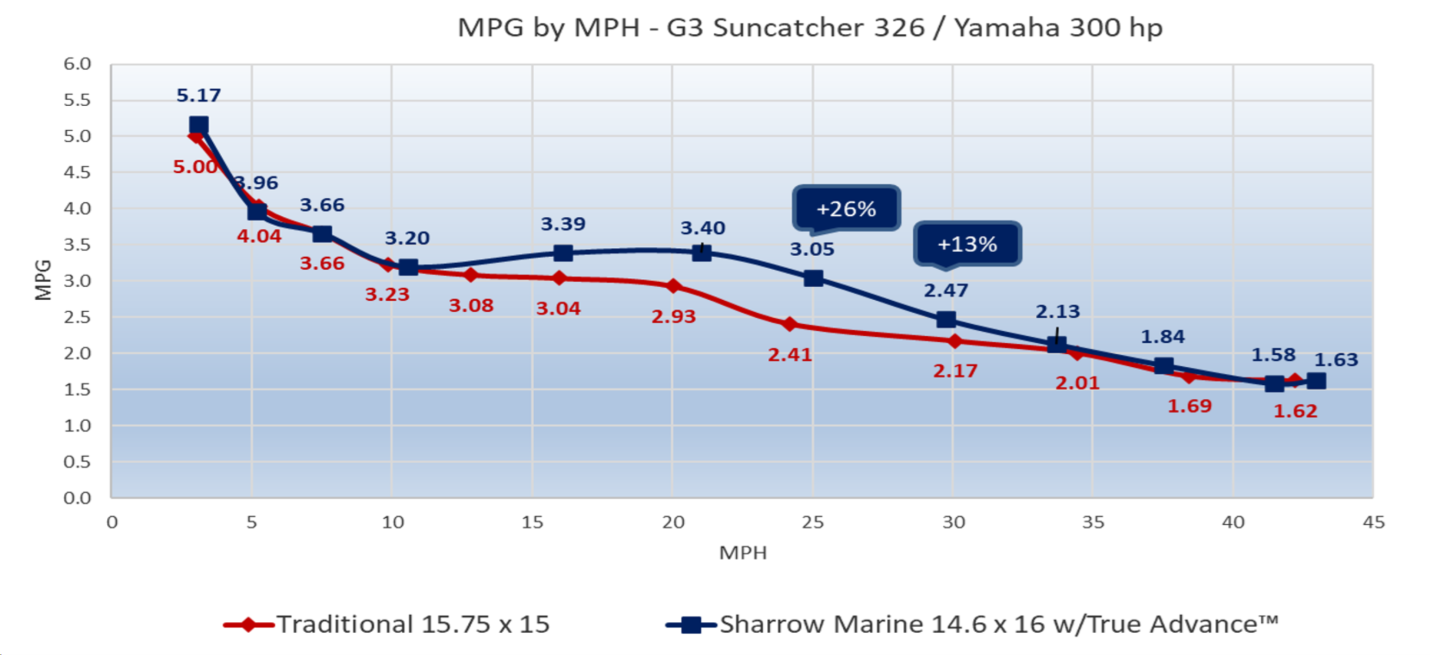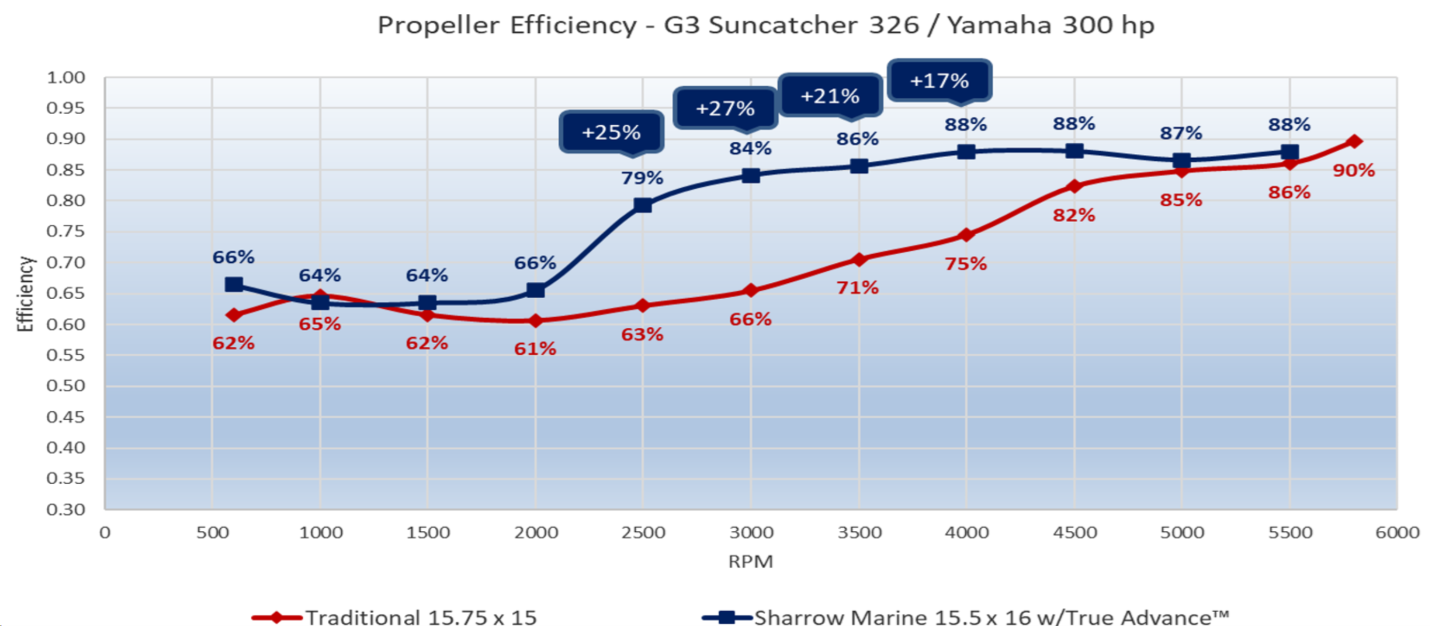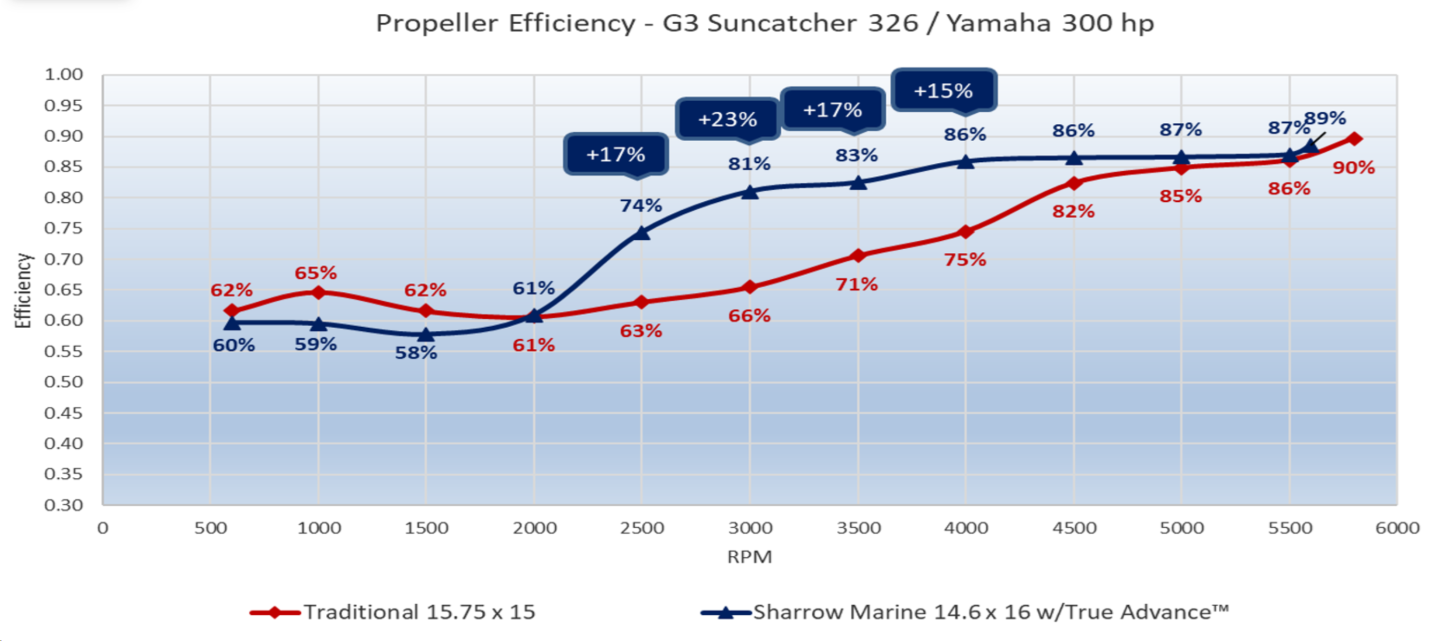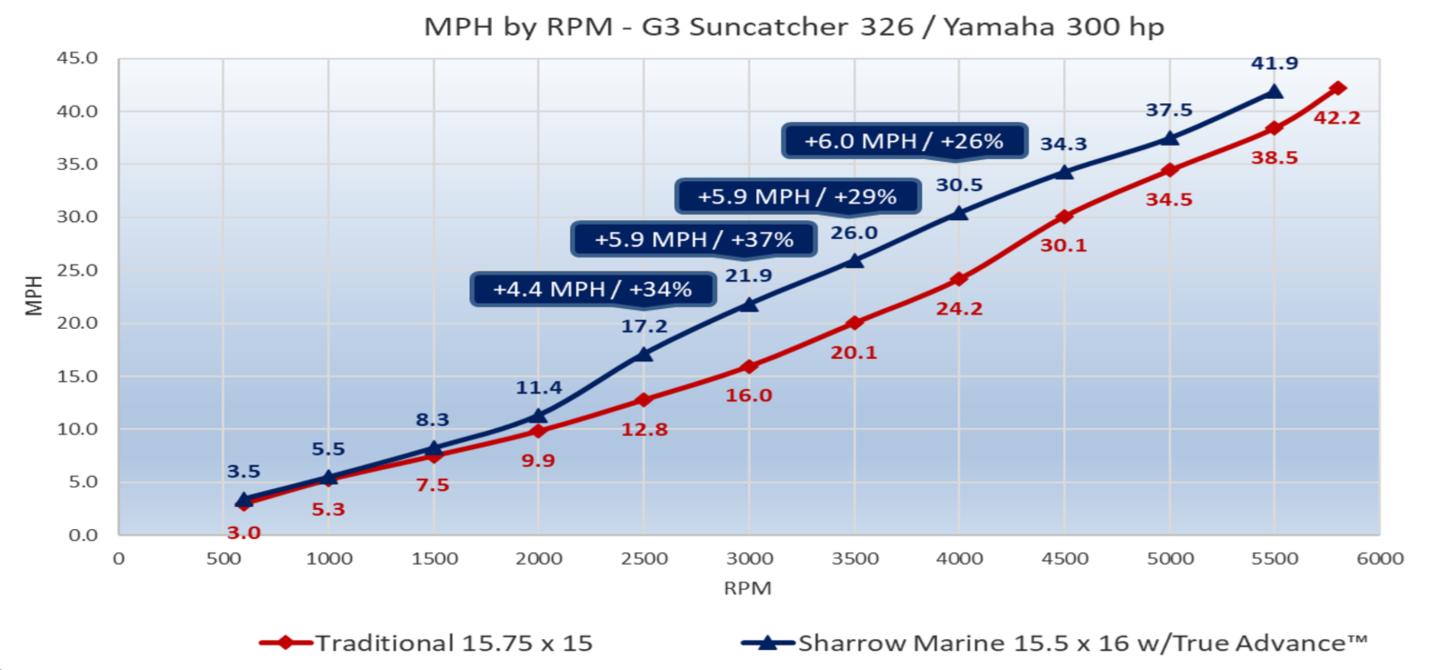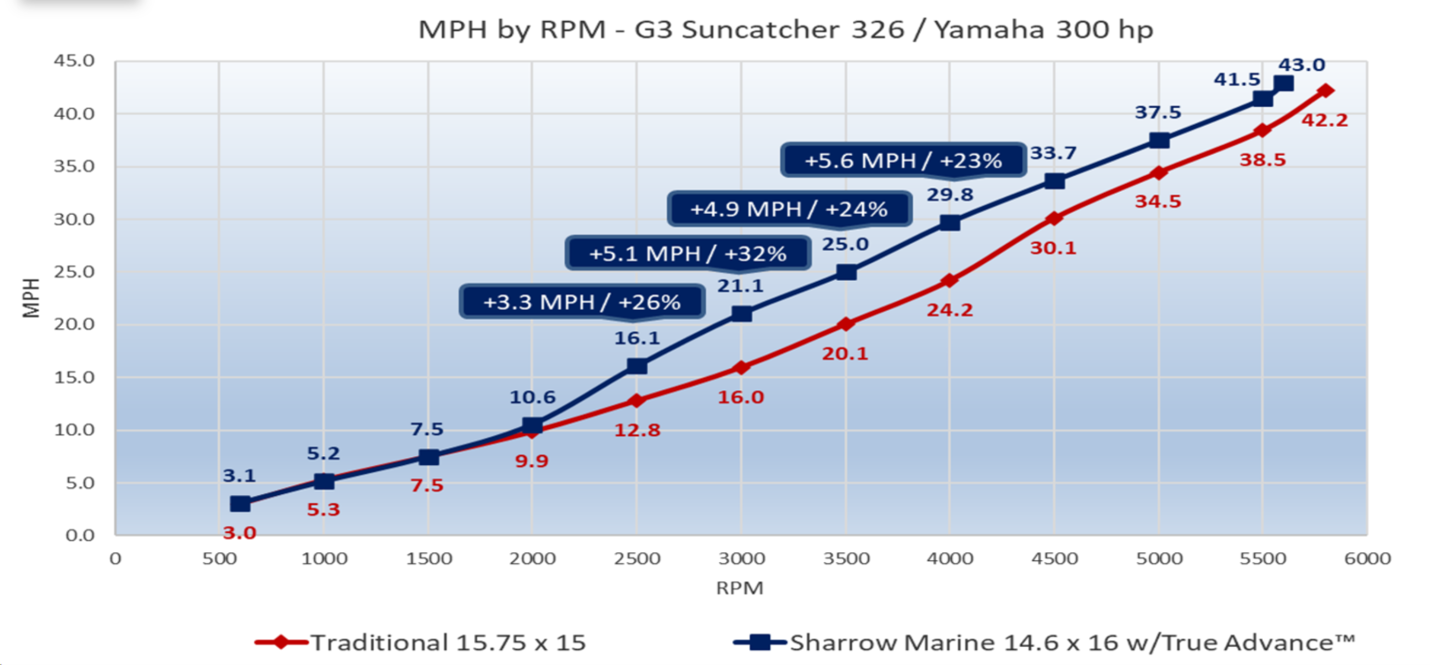Sharrow Props Pass the Pontoon Boat Test
Several months ago, we published a report on the performance of a tri-toon with Sharrow props. As usual, it was more economical in the mid-range, but the thing that the owner remarked on most was turning without ventilation and it was the ride was much quieter with the Sharrows.
Check out this extensive testing on a G3 Suncatcher 326 to see what we mean. The 326 is a 26’5” (8.05 m) tritoon weighing 3,340 lbs. dry (1,515 kg). Suncatcher is a Yamaha company, and the 326 is designed to handle Yamaha outboards to 300-hp.
BoatTEST did not test this boat, and all numbers presented are from the Sharrow tech team. They tested the package with two Sharrow True Advance propellers, one with a 14.6” pitch, the other with a 15.5” pitch. Both had 16” diameters. The standard prop was 15.75 x 15.
Fuel Efficiency – Comparing 2 Sharrow Props
In the chart above, we see how the 15.5 x 16 Sharrow prop compares with the standard prop. Note the Sharrow improvement in fuel economy over the conventional propeller in the mid-range where pontoon boats run most often. The Sharrow Marine True Advance 15.5” propeller showed a 23% advantage from 15 to 20 mph, 24% from 20 to 25 mph, 26% from 25 to 30 and 14% from 30 to 35 mph. From 35 to WOT, the two propellers produced near identical results.
The results were less dramatic with the 14.6” pitch Sharrow prop but still impressive, peaking at 26% better at 25 mph, 13% better at 30 mph.
While the savings in fuel cost are great, even more important to some boaters might be the equivalent extension in range, allowing for longer excursions and less “range anxiety” on extended days on the water.
Diameter Matters
In both cases, the Sharrow props were 16” in diameter, a full inch greater than the standard conventional prop. This means that the Sharrow props had a lot more surface area to grab the water and create more thrust. Further, the Sharrow continuous blade prop effectively has 6 blades, not 3. That means the Sharrow props have more surface area: 1” greater diameter times 3 more effective prop blades.
Advance Rate
Note that the above test was of a Sharrow prop with a 15.5" pitch. The one below records the advance of a Sharrow prop with nearly 1” less pitch.
All Sharrow props were not created equal. In this test, the Sharrow 15.5” propeller peaked at lower rpm than the conventional propeller but was moving the boat faster at that point. And the 14.6 x 16 had a significant advantage in the advance rate all the way from 2000 rpm to full throttle. Again, it peaked at lower rpm but in this case delivered a slightly lower speed (see below).
Propeller Efficiency
Prop Slip Hurts
Here’s how to read this chart: the pitch of the standard prop was 15.75 inches, and if the boat had been advancing 15.75 inches forward during every 360-degree revolution, its efficiency would be 100%. As you can see for most of the RPM band the standard props was 61% to 66% efficient and did not get into the 70s and 80s until above 4500 RPM.
What you are seeing in this chart is what is generally called “prop slip.” This is the difference between the theoretical advance of the boat with each 360-degree rotation of the prop, and its actual advance. Makers of conventional props don’t like to talk about this subject, and above you see the reason why.
Most standard props don’t reach their top efficiency – in this case 90% -- until WOT speeds, where no one operates their boat for more than a few minutes.
In terms of propeller efficiency, getting the most from a given rpm, the 15.5” pitch True Advance Sharrow props showed large advantages between 2000 and 4500 rpm—almost the entire on-plane operating range of the package.
The difference in efficiency was somewhat less pronounced with the Sharrow 14.6 True Advance, but still very significant up to about 4500 rpm.
According to the company (and our tests) Sharrow’s True Advance™ propellers deliver nearly their maximum efficiency as soon as the boat reaches planing speed, while conventional propellers only approach max efficiency at near full throttle.
Boat Speed
In terms of speed at various rpm, the Sharrow 15.5 x 16 model produced dramatic improvements in mid-range, maxing out at 37% better at 3000 rpm, 26% better at 4000 rpm. It was, however, slightly slower at WOT—0.3 slower.
The Sharrow 14.6" pitch model produced impressive advantages in speed at various rpm from 2000 to WOT on the Suncatcher, with a 32% advantage at 3000 rpm. It was also a bit better at WOT, 0.8 mph faster.
Our BoatTEST team in tests it has conducted has consistently reported better low speed handling with Sharrow propellers, particularly in reverse, where the added grip on the water is a great asset in slowing a boat as well as maneuvering it around the docks.
Clearly, Greg Sharrow and his team have created the most dramatic advance in propeller performance in over 100 years.
Overall, the dramatic improvements in propeller technology with Sharrow propellers that the BoatTEST captains have verified are:
• Greater Efficiency in the Mid Range
• Greater Range at Best Cruise
• Increased Load Capacities by Inference
• Faster Speeds (up to 10 MPH FASTER) at Cruising RPM’s
• Enhanced Handling and Maneuvering
• Greater Reverse Thrust, Greater Stopping Power
• Much Quieter Operation
• Less Vibration, therefore Less Operator Fatigue
Sharrow propellers are more expensive than conventional propellers. But based on our tests over the last four years, it’s clear that on most boat and motor packages run regularly, they save significant money on fuel and overall create a better boating experience.


